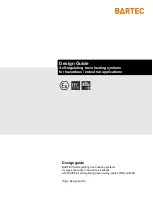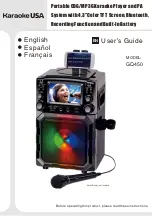
ELECTRO-VOICE
®
Xi-A Rigging Manual
11
WHEN SUSPENDING ANY Xi-A LOUDSPEAKER SYSTEM OVERHEAD, THE
WORKING-LOAD LIMIT MUST NEVER BE EXCEEDED FOR EACH INDIVIDUAL
RIGGING POINT, AND THE WORKING-LOAD LIMIT MUST NEVER BE
EXCEEDED FOR THE OVERALL ENCLOSURE.
The user must be aware of both of the above working-load-limit ratings at all times. An Xi-A loud-
speaker system is only as strong as its weakest link. In most applications, it is usually the case
that one of the working-load limits will be approached sooner than the other. For example, if only
two rigging points are employed, the weakest link will always be the individual rigging points and
the working-load limit for the individual rigging points will always be the dominant factor If, how-
ever, four rigging points are used, the weakest link may be either the overall enclosure or the
individual rigging points depending on the angles of pull on the rigging points. The individual
rigging points on each Xi-A loudspeaker system have two working-load-limit ratings, one when
used with a double-stud ring fitting (as used on the GS-1B, LS-1B, LS-2B, LS-3B and RS-1B
rigging accessories), and one when used with a single-stud fitting (as used on the RS-2B rigging
accessory). Two working-load-limit ratings are required because the double-stud and single-stud
fittings have different strength ratings. In addition, those strength ratings will vary with the angle of
pull relative to the surface on which the rigging track is mounted. There is only one working-load-
limit rating for the overall enclosure of each Xi-A loudspeaker system, and that rating is indepen-
dent of the angles of pull. Specifically, the flying Xi-1191AF, Xi-1183A, Xi-1153A, Xi-2181AF, Xi-
2153A, Xi-1122MHA, and Xi-2122MHA loudspeaker systems have the following strength ratings.
When used with double-stud fillings (as used on the GS-1B LS-1B, LS-2B, LS-3B and RS-1B
rigging accessories), the working-load limit rating of each individual rigging point is 500 pounds at
a pull angle of 0° (i.e., perpendicular to the surface on which the track is mounted), 437 pounds at
a pull angle of 45° and 375 pounds at a pull angle of 90° (i.e., parallel to the surface on which the
track is mounted). When used with single-stud fittings (as used on the RS-2B rigging accessory),
the working-load-limit rating of each individual rigging point is 250 pounds at any pull angle. The
working-load-limit rating of the overall enclosure is 1,000 pounds. Electro-Voice insists that the
user must never apply a load to any Xi-A flying loudspeaker system that exceeds the working-load
limit rating of either the individual rigging point or the overall enclosure. The strength ratings of the
flying Xi-1191AF, Xi-1183A, Xi-1153A, Xi-2181AF, Xi-2153A, Xi-1122MHA, and Xi-2122MHA loud-
speaker systems are summarized in Figure 4.1a. Specifically, the flying Xi-1122A, Xi-1152A, Xi-
1123A and Xi-2123A loudspeaker systems have the following strength ratings. When used with
double-stud fittings (as used on the GS-1B LS-1B LS-2B, LS-3B and RS-1B rigging accessories),
the working-load limit rating of each individual rigging point is 500 pounds at any pull angle. When
used with single-stud fittings (as used on the RS-2B rigging accessory), the working-load-limit
rating of each individual rigging point is 250 pounds at any pull angle. The working-load-limit rating
of the overall enclosure is 750 pounds. Electro-Voice insists that the user must never apply a load
to any Xi-A flying loudspeaker system that exceeds the working-load limit rating of either the
individual rigging point or the overall enclosure. The strength ratings of the flying Xi-1122A, Xi-
1152A, Xi-1123A and Xi-2123A loudspeaker systems are summarized in Figure 4.1b. All associ-
ated mechanical components used with any Xi-A flying system (shackles, chains, hoists, wire-rope
slings, nylon and/or polyester slings, etc.) should be load rated for overhead lifting. All load-rated
hardware will typically have its load rating displayed on each piece in a visible location. Typical
ratings are denoted as the static-working load (SWL), or the working-load limit (WLL). These
ratings generally assume a safety factor of 5:1; however, the user should consult the hardware
manufacturer to confirm the rating. Occasionally, the load rating is given as the ultimate-break






































